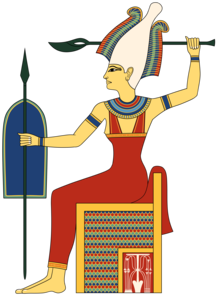| Anat | |||||||
|---|---|---|---|---|---|---|---|
Goddess of war and hunting | |||||||
 | |||||||
| Other names | Ḫanat[1] | ||||||
| Name in hieroglyphs |
| ||||||
| Major cult center | Ḫanat, Ugarit, Tanis | ||||||
| Symbol | Atef Crown, wings[2] | ||||||
| Parents | |||||||
| Consort | |||||||
| Equivalents | |||||||
| Greek | Athena[8] | ||||||
| Mesopotamian | Ninurta[9] | ||||||
| Deities of the ancient Near East |
|---|
| Religions of the ancient Near East |
Anat (/ˈɑːnɑːt/, /ˈænæt/), Anatu, classically Anath (/ˈeɪnəθ, ˈeɪˌnæθ/; Ugaritic: 𐎓𐎐𐎚 ʿnt; Hebrew: עֲנָת ʿĂnāṯ; Phoenician: 𐤏𐤍𐤕, romanized: ʿNT; Greek: Αναθ, romanized: Anath; Egyptian: ꜥntjt) was a goddess associated with warfare and hunting, best known from the Ugaritic texts. Most researchers assume that she originated in the Amorite culture of Bronze Age upper Mesopotamia, and that the goddess Ḫanat, attested in the texts from Mari and worshiped in a city sharing her name located in Suhum, should be considered her forerunner.
In Ugarit, Anat was one of the main goddesses, and regularly received offerings, as attested in texts written both in the local Ugaritic language and in Hurrian. She also frequently appears in myths, including the Baal Cycle and the Epic of Aqhat. In the former, she is portrayed as a staunch ally of the weather god Baal, who assists him in his struggle for kingship, helps him with obtaining the permission to obtain a dwelling of his own, and finally mourns and avenges his death at the hands of the personified death, Mot. The precise nature of the relation between Anat and Baal is uncertain, and the conventional views that they were lovers, siblings or both remain a matter of dispute among researchers. Another deity who frequently appears alongside her is Ashtart. Interactions between Anat and the sun goddess Shapash and moon god Yarikh are described in myths as well. In Hurrian ritual texts, she appears alongside deities such as Šimige, Aštabi and Nupatik. Elsewhere in the Levant and in nearby regions of inland Syria, Anat's status apparently was not equally high, though she is nonetheless attested in Emar, Hazor and elsewhere.
At some point in time in the Bronze Age, either during the reign of Hyksos or shortly after its end, Anat was introduced to Egypt, and achieved a degree of prominence during the reign of Ramesses II, whose devotion to her is well attested. Evidence for Egyptian worship of Anat is also available from various sites in Palestine which were controlled by the pharaohs in the Bronze Age. She remained a part of the Egyptian pantheon as late as in the Roman period. In the first millennium BCE, she also continued to be worshiped in Suhum in Mesopotamia. She is also attested in a number of Phoenician inscriptions. Most of them come from Cyprus. They indicate that on this island an association developed between her and the Greek goddess Athena based on their similar character. The only references to Anat in the Hebrew Bible are indirect, and are limited to toponyms and theophoric names, which is presumed to indicate that she was not commonly worshiped in the Kingdom of Israel.
Anat was characterized as a fertility goddess associated with human sexuality in early scholarship, but despite the occasional modern support, this view is no longer the consensus among experts. Proposed etymologies of her name and interpretations of texts she appears in are a subject of criticism. The view that goddesses of Ugarit and other nearby areas were interchangeable and had no individual traits, which often shaped early publications about Anat, is also no longer accepted.
- ^ Watson 1993, p. 48.
- ^ Cornelius 2008, p. 30.
- ^ Rahmouni 2008, p. 250.
- ^ Wiggins 2007, p. 67.
- ^ Zivie-Coche 2011, p. 6.
- ^ Smith 2014, pp. 59–60.
- ^ Smith 2014, p. 60.
- ^ Day 1999, p. 39.
- ^ Na’aman 2005, p. 248.